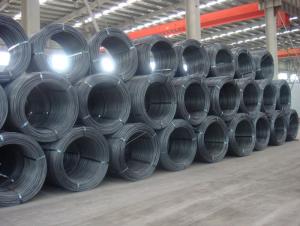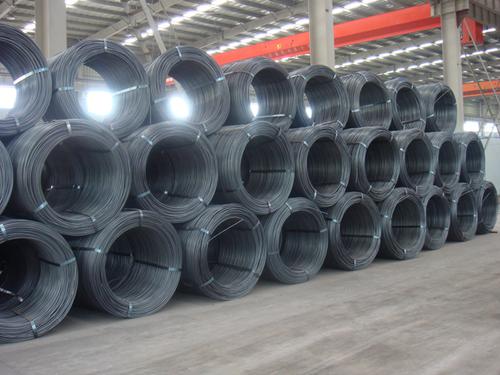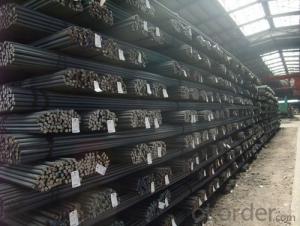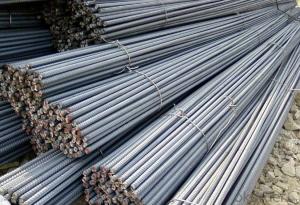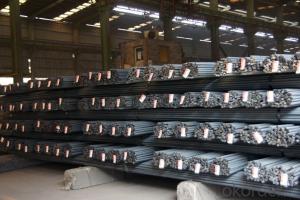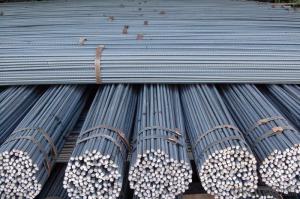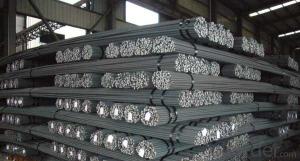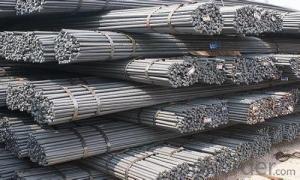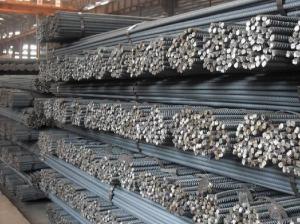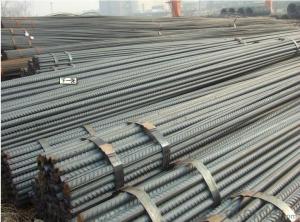Deformed Steel Bar In Coil CRB600H
- Loading Port:
- China Main Port
- Payment Terms:
- TT OR LC
- Min Order Qty:
- -
- Supply Capability:
- -
OKorder Service Pledge
OKorder Financial Service
You Might Also Like
Usage and Applications of HRB400 Deformed Steel Bar:
Deformed bar is widely used in buildings, bridges, roads and other engineering construction. Big to highways, railways, bridges, culverts, tunnels, public facilities such as flood control, dam, small to housing construction, beam, column, wall and the foundation of the plate, deformed bar is an integral structure material. With the development of world economy and the vigorous development of infrastructure construction, real estate, the demand for deformed bar will be larger and larger..
Packaging & Delivery of HRB400 Deformed Steel Bar:
Packaging Detail: products are packed in bundle and then shipped by container or bulk vessel, deformed bar is usually naked strapping delivery, when storing, please pay attention to moisture proof. The performance of rust will produce adverse effect.
Each bundle weight: 2-3MT, or as required
Payment term: TT or L/C
Delivery Detail: within 45 days after received advanced payment or LC.
Label: to be specified by customer, generally, each bundle has 1-2 labels
Trade terms: FOB, CFR, CIF
Deformed Steel Bar in container
- Q: Are steel rebars suitable for use in high-temperature applications?
- High-temperature applications are generally not suitable for the use of steel rebars. Despite being a strong and durable material, steel has limitations when exposed to high temperatures. It can undergo a significant reduction in strength and even a loss of structural integrity, leading to potential failures. When subjected to high temperatures, steel goes through a process known as thermal expansion, which can weaken and deform it. This phenomenon is particularly noticeable in rebars, which are commonly used to reinforce concrete structures. The high temperatures cause the rebars to expand, exerting excessive pressure on the surrounding concrete. This pressure can result in cracks and potentially compromise the stability of the structure. Furthermore, prolonged exposure to high temperatures can cause a loss of the steel's mechanical properties, including its tensile strength and load-bearing capacity. As a result, the rebars become less effective in resisting external forces and reinforcing the concrete. For this reason, it is generally recommended to consider alternative materials, such as stainless steel or special alloys, for high-temperature applications. These materials are specifically designed to withstand elevated temperatures without compromising their structural integrity. To ensure safety and structural stability, it is important to consult with experts and engineers who are familiar with high-temperature applications in order to determine the most suitable materials for specific projects.
- Q: Can steel rebars be used in architectural or decorative concrete applications?
- Yes, steel rebars can be used in architectural or decorative concrete applications. They provide structural reinforcement and enhance the overall strength and durability of the concrete. Additionally, when properly designed and installed, steel rebars can be concealed or incorporated into the design, making them suitable for various aesthetic purposes in architectural or decorative concrete projects.
- Q: What are the considerations for using epoxy-coated steel rebars?
- When considering the use of epoxy-coated steel rebars, there are several important factors to take into account. These considerations include the corrosion resistance, durability, cost-effectiveness, and construction requirements. One primary consideration is the corrosion resistance provided by epoxy-coated steel rebars. The epoxy coating acts as a protective barrier against moisture, chemicals, and other corrosive elements that are typically present in concrete structures. This coating significantly reduces the risk of corrosion, thus increasing the lifespan of the rebar and the overall durability of the reinforced concrete. Durability is another key consideration. Epoxy-coated steel rebars are designed to withstand harsh environmental conditions, including exposure to chloride ions, which are known to accelerate corrosion in traditional black steel rebars. This enhanced durability ensures that the structure remains structurally sound over an extended period, reducing the need for costly repairs or replacements. Cost-effectiveness is also an important consideration. While epoxy-coated steel rebars may have a higher initial cost compared to black steel rebars, their long-term cost-effectiveness is evident. The reduced risk of corrosion and subsequent maintenance or repair expenses can result in significant savings over the life of a structure. Additionally, the extended lifespan of the rebar can contribute to lower life-cycle costs. Construction requirements must also be taken into consideration when using epoxy-coated steel rebars. The application of the epoxy coating requires careful handling and storage to prevent damage or contamination. Special care must be taken during transportation, storage, and installation to ensure the integrity of the coating. Contractors must also be trained and experienced in working with epoxy-coated steel rebars to ensure proper installation and adherence to industry standards. In conclusion, the considerations for using epoxy-coated steel rebars include their corrosion resistance, durability, cost-effectiveness, and the specific construction requirements they impose. While they may have a higher initial cost and require additional care during handling and installation, the long-term benefits of increased corrosion resistance and durability make them a favorable choice for reinforced concrete structures.
- Q: How long do steel rebars typically last before corroding?
- Steel rebars typically last a significant amount of time before corroding, but the exact duration can vary depending on several factors. Generally, rebars are designed to have a service life of around 50 to 100 years. However, this estimate can change based on the environment and conditions in which the rebars are exposed. Corrosion of steel rebars occurs when they are exposed to moisture, oxygen, and other corrosive elements, such as chloride ions. Factors such as humidity, temperature, pH level of the surrounding environment, and the presence of chemicals can all influence the rate at which corrosion occurs. In areas with high humidity or near coastal regions where saltwater spray is prevalent, rebars may corrode at a faster rate due to the presence of chloride ions. On the other hand, in dry and less corrosive environments, rebars may last longer before showing signs of corrosion. To enhance the durability and longevity of steel rebars, various corrosion prevention techniques and protective measures can be employed. These include applying coatings or paints to the rebars, using stainless steel rebars, incorporating corrosion inhibitors in the concrete mix, and ensuring proper concrete cover thickness to shield the rebars from environmental exposure. Regular maintenance and inspections are also essential to identify any signs of corrosion early on and take appropriate measures to repair or replace the affected rebars. Overall, the lifespan of steel rebars before corrosion is influenced by multiple factors, and proper preventive measures can significantly extend their durability.
- Q: What are the guidelines for reinforcing concrete slabs with steel rebars?
- When reinforcing concrete slabs with steel rebars, there are several important factors to consider. Firstly, the required amount of reinforcement must be determined based on the load that the slab will bear. This load can be calculated using structural engineering principles and taking into account factors such as the intended use of the slab, the weight of any equipment or vehicles that will be placed on it, and any applicable building codes or regulations. Once the necessary amount of reinforcement is determined, the next step is to design the layout of the rebars. This involves spacing them at specified intervals to ensure an even distribution of the load across the slab. The spacing will vary depending on the thickness of the slab, with thicker slabs generally requiring more rebars. It is also important to include minimum clearances between the rebars and the edges or bottom of the slab to prevent corrosion and ensure proper concrete cover. The size and type of rebars used is another important consideration. Commonly used types include plain round bars, deformed bars, or welded wire fabric. The diameter of the rebars and the grade of steel should be selected based on the expected load and the requirements of the project specifications or building codes. During the construction process, it is crucial to correctly place and secure the rebars within the formwork to maintain their intended position. This may involve using chairs, spacers, or other devices to ensure proper alignment and prevent displacement. Additionally, care should be taken to avoid damaging the rebars during the pouring and finishing of the concrete. Lastly, it is important to inspect and test the reinforced concrete slab to ensure that the rebars are properly installed and meet the required specifications. This can involve visual inspections, as well as non-destructive testing methods such as ultrasound or ground-penetrating radar to verify the integrity and position of the rebars. In conclusion, adhering to these guidelines for reinforcing concrete slabs with steel rebars will help guarantee the structural integrity and longevity of the slab, while also meeting necessary safety and building code requirements.
- Q: How do steel rebars contribute to the overall ductility of a structure?
- Steel rebars contribute to the overall ductility of a structure by providing reinforcement and enhancing its ability to withstand deformations and absorb energy without failure. The addition of rebars in concrete structures improves its tensile strength, as concrete alone is weak in tension. This combination allows the structure to flex and bend under loading, reducing the risk of brittle failure and increasing its overall resilience.
- Q: How are steel rebars used in the construction of power transmission towers?
- Steel rebars are commonly used in the construction of power transmission towers to reinforce the concrete foundations and provide structural stability. They are placed within the concrete to enhance its tensile strength and resistance to bending, ensuring the tower's ability to withstand the weight of the structure and the forces exerted by wind and load.
- Q: What is the recommended minimum cover for steel rebars in concrete?
- The recommended minimum cover for steel rebars in concrete is typically around 1.5 inches (or 40 millimeters). However, specific construction codes and design requirements may vary depending on factors such as environmental conditions, structural considerations, and the intended use of the concrete. It is always advisable to consult the relevant building codes or consult with a structural engineer for the appropriate minimum cover requirements for a particular project.
- Q: How do steel rebars contribute to the overall sustainability of the construction industry?
- Steel rebars contribute to the overall sustainability of the construction industry in several ways. Firstly, steel rebars are made from recycled materials, reducing the demand for new resources and minimizing the environmental impact of steel production. Additionally, steel rebars are highly durable and have a long lifespan, ensuring the longevity and stability of structures, reducing the need for frequent repairs or replacements. Moreover, the use of steel rebars in reinforced concrete allows for the construction of taller and more complex structures, maximizing the efficient use of land and reducing the need for additional construction projects. Overall, steel rebars play a crucial role in improving the sustainability of the construction industry by promoting resource conservation, durability, and efficient construction practices.
- Q: Can steel rebars be used in fire-resistant structures?
- Yes, steel rebars can be used in fire-resistant structures. The high melting point and strength of steel make it a suitable material for reinforcing concrete in buildings that need to withstand fire. Additionally, steel rebars are often coated with fire-resistant materials to enhance their fire resistance properties.
Send your message to us
Deformed Steel Bar In Coil CRB600H
- Loading Port:
- China Main Port
- Payment Terms:
- TT OR LC
- Min Order Qty:
- -
- Supply Capability:
- -
OKorder Service Pledge
OKorder Financial Service
Similar products
Hot products
Hot Searches
Related keywords
